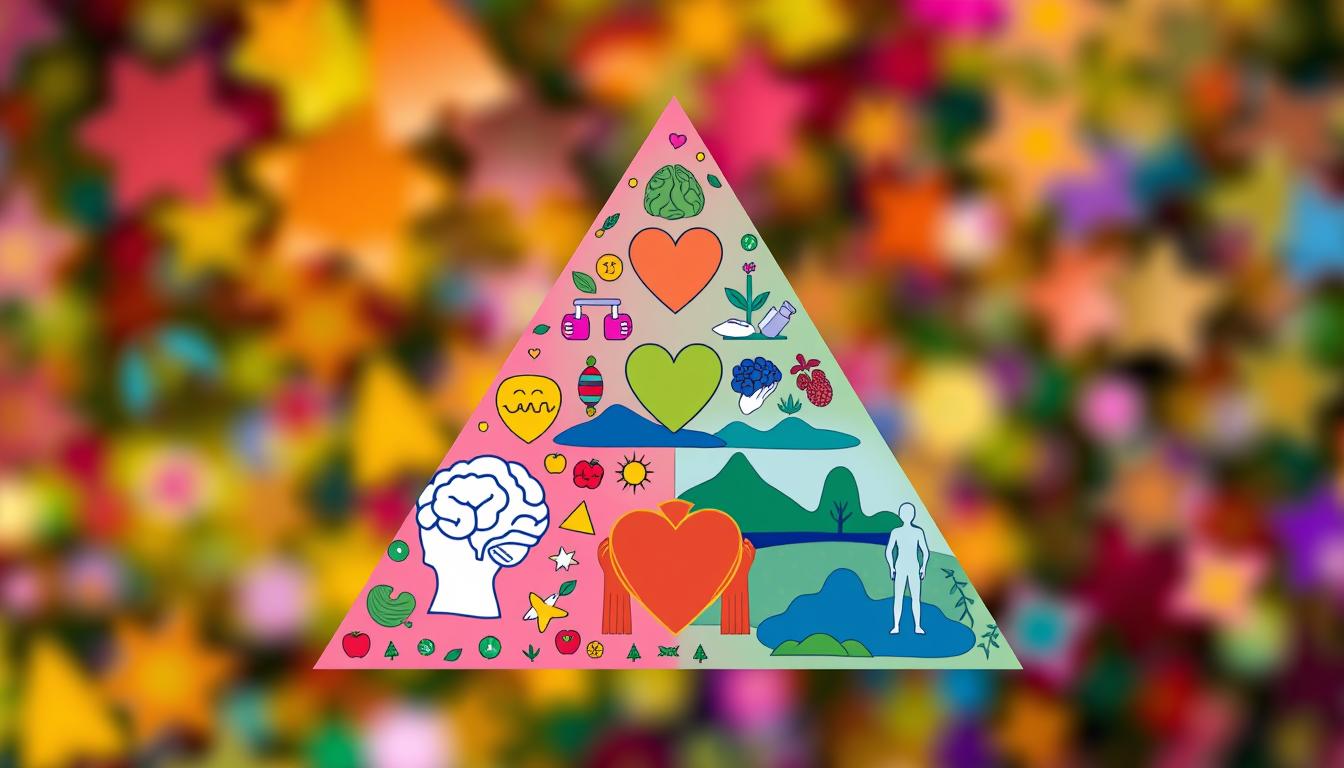health triangle

The health triangle shows how your physical, mental, and social health are connected. It was first used in 1997 by a middle school in Alaska. Later, the World Health Organization (WHO) adopted it, showing its value.
The WHO says health means being fully physically, mentally, and socially well. It’s not just about not being sick. By focusing on the health triangle, you aim for a balanced life. Each part helps the others.
Understanding the health triangle is key. It helps you see how all parts of your well-being are linked. Whether you want to get fit, feel emotionally strong, or build better relationships, the health triangle guides you. It’s a proven way to achieve lasting wellness.
Table of Contents
Understanding the Origins and Evolution of the Health Triangle
The health triangle idea started in Alaska as a class project. It has since become a global concept recognized by the World Health Organization (WHO). It shows how physical, mental, and social health are all connected. This idea has become popular in health and wellness circles, helping people find balance in their lives.
The WHO’s Definition and Adaptation
The WHO says health is more than just not being sick. It’s about being physically, mentally, and socially well. This idea has made the health triangle a key part of health care. It shows that all parts of health are equally important.
Historical Development from Alaska to Global Recognition
The health triangle idea started in Alaska, thanks to a class project. It quickly grew, becoming a model supported by the WHO. Now, it’s known worldwide, inspiring health and wellness efforts everywhere.
Core Principles of the Triadic Model
The health triangle is all about balance and harmony. It focuses on physical, mental, and social health. If any part is ignored, overall health suffers. The health triangle teaches us to care for all aspects of our well-being.
“The health of the body and the health of the mind are one. What benefits the one benefits the other. To preserve the health of both is a primary duty.” – Swami Sivananda
The Three Pillars of Health Triangle
The triadic wellness philosophy says true health comes from three key areas: physical, mental, and social. This whole-person health paradigm shows how these areas are connected. It says ignoring any one can harm our overall health and happiness.
Physical Health: The Foundation
Physical health means our body works right, we eat well, exercise, sleep enough, and stay clean. Choices like exercising, eating right, not smoking, and drinking in moderation help keep us healthy.
Mental Health: Emotional Well-being
Mental health is about our feelings, thoughts, and how we handle stress. Managing stress and staying positive are key. A positive outlook helps us deal with life’s ups and downs better.
Social Health: Meaningful Connections
Social health is about our relationships, how we talk to others, and being part of our community. Having friends and family who support us is vital. Joining in community activities helps us feel connected and valued.
The triadic wellness philosophy shows that all three areas are linked. Working on them together is key to feeling our best. By focusing on physical, mental, and social health, we can live a balanced and fulfilling life.
Physical Health: Building Your Foundation for Wellness
Physical health is key to the self-care trifecta and a multidimensional well-being strategy. It’s important to focus on three main areas. These are exercise and movement, nutrition and hydration, and sleep quality and recovery.
Exercise and Movement Guidelines
The American Heart Association suggests at least 150 minutes of moderate-intensity aerobic activity weekly. Or, you can do 75 minutes of vigorous-intensity aerobic activity. Also, do strength-training exercises on two or more days each week.
Start slowly and increase your workout time and intensity. This helps avoid injuries and supports long-term progress.
Nutrition and Hydration Essentials
Eat a balanced diet with lots of fruits, vegetables, whole grains, and lean proteins. Drinking enough water is also key. Our bodies are about 60% water.
Sleep Quality and Recovery
Getting 7-9 hours of sleep each night is crucial for recovery and well-being. Lack of sleep can lead to mood disorders like depression and anxiety.
By focusing on these three areas, you build a strong foundation for your self-care trifecta and multidimensional well-being strategy. A healthy body supports a healthy mind and strong social connections. This creates a balanced Health Triangle.

Mental Health: Nurturing Your Emotional Well-being
The harmonious life trinity and wellness triad are key to a balanced life. Physical and social health are important, but mental health is crucial. It helps you reach your full potential.
Stress management techniques like mindfulness, meditation, and journaling boost your mental strength. These practices help you deal with tough times and find peace within. Positive thinking and self-compassion also improve your emotional state, leading to better choices and relationships.
Mental health affects your physical health and how you interact with others. Ignoring it can lead to serious problems. That’s why getting help when needed is vital for your mental wellness. This ensures all parts of the harmonious life trinity support your well-being.
“The greatest weapon against stress is our ability to choose one thought over another.” – William James
Understanding the wellness triad is essential for a harmonious life. Taking care of your emotional health is the first step. It sets the stage for a life where physical, mental, and social health are in balance.
Social Health: Strengthening Your Connections
The holistic health model shows how physical, mental, and social health are connected. Social health is just as important as physical and mental health for your overall wellness. Having strong social connections can greatly improve your integrative health approach.
Building Support Networks
Having a strong support network is key for social health. This network includes family, friends, and community. It gives you emotional support, fights loneliness, and helps your physical and mental health.
Studies show people with strong social ties live up to 50% longer than those without. This is a big reason why social health matters.
Community Engagement Benefits
Getting involved in your community can boost your social health. Activities like volunteering or joining local groups can expand your social circle. They also give you a sense of belonging and purpose.
Research shows that those who are less involved in social relationships are more likely to die. This highlights the importance of community engagement.
Communication Skills Development
Good communication skills are vital for healthy relationships. They help you express yourself, listen well, and solve conflicts. These skills lead to deeper, more meaningful connections.
They also improve your holistic health model and life satisfaction. So, working on your communication skills is a smart move.
“Social relationships have been identified by the World Health Organization as a worldwide health priority due to their significant impact on longevity.”
By focusing on your social health and building strong connections, you can benefit from a integrative health approach. This will improve your overall well-being.
The Interconnected Nature of Wellness Components
The health triangle shows how mind-body-spirit balance is key to whole-person health paradigm. Physical, mental, and social well-being are all connected. Ignoring one can harm the others.
Poor physical health can make you feel sad and lonely. But, having strong social connections can boost both your mind and body. It’s important to see how these areas affect each other.
The Wellness Wheel breaks down well-being into eight parts: physical, emotional, social, spiritual, occupational, intellectual, environmental, and financial. Working on all these areas is crucial for being truly healthy and full of life.

Knowing how these wellness parts work together helps us take better care of ourselves. It lets us make smart choices, build good habits, and live a life that’s good for our mind, body, and spirit.
Signs of an Unbalanced Health Triangle
A balanced well-being strategy focuses on three key areas: physical, mental, and social health. But, an imbalance can show up in many ways.
Physical Imbalance Indicators
Physical signs of imbalance include chronic fatigue and unexplained weight changes. Frequent illnesses are also a red flag. Neglecting the body’s needs can weaken the immune system and harm overall health.
Mental Health Warning Signs
Mental health issues like persistent sadness and anxiety are signs of imbalance. Emotional well-being is vital. Neglecting it can have serious effects.
Social Wellness Red Flags
Social imbalance shows as feelings of isolation and trouble with relationships. Avoiding social interactions is another sign. Lack of social support can affect a person’s sense of belonging and purpose.
Spotting these signs early is key to achieving balance. By tackling physical, mental, and social imbalances, one can move towards a more balanced and fulfilling life.
Strategies for Maintaining Balance in Your Health Triangle
Keeping a balance in the health triangle is key for a happy life. This includes physical, mental, and social health. It takes work, but the benefits are huge. By adding certain habits to your day, you can care for all parts of your health and live a harmonious life trinity.
Physical Health: Nourish Your Body, Energize Your Mind
Eat a balanced diet with lots of fruits, veggies, proteins, and grains. The American Heart Association says to do 150 minutes of moderate exercise weekly. Also, do strength training twice a week. And, sleep well, aiming for 7-9 hours each night.
Mental Health: Cultivate Inner Peace and Emotional Resilience
Learn to manage stress with mindfulness, journaling, or hobbies. Take care of your emotions by sharing them in a healthy way. Do things that make you grow as a person and stay positive. If you need help, get professional advice.
Social Health: Strengthen Connections, Enrich Your Life
Focus on keeping strong relationships with friends, family, and community. Do things together, volunteer, or join clubs. Good communication skills help build strong bonds and relationships.
By following these tips, you can find balance in your health triangle. Remember, small steps towards self-care can lead to a harmonious life trinity.
| Health Assessment | Rating (1-5) |
|---|---|
| Physical Health | 4 |
| Social Health | 3 |
| Mental and Emotional Health | 4 |
“Maintaining a balanced health triangle requires ongoing effort, but the rewards are immense. By nurturing all three pillars – physical, mental, and social well-being – you can achieve a truly harmonious life.”
Common Challenges and Solutions in Health Triangle Management
Starting a journey with the triadic wellness philosophy and an integrative health approach can be life-changing. Yet, it’s not without its challenges. Finding a balance between physical, mental, and social health is a big hurdle.
Time and other priorities often get in the way of self-care. But, you can manage your time better and make space for health activities. Mindfulness and stress-relief can also help you stay healthy in today’s fast-paced world.
Technology is great for tracking health and connecting with others online. But, it can lead to too much sitting and feeling lonely if not used wisely. It’s important to balance digital life with real-life connections. This way, you can keep your social circle strong and avoid too much screen time.
FAQ
What is the health triangle?
The health triangle shows how well-being is made up of physical, mental, and social health. It shows how these three parts work together for a healthy life and wellness.
How did the health triangle concept develop?
It started as a school project in Alaska in 1997. The World Health Organization (WHO) later adopted it. The WHO says health is being fully physically, mentally, and socially well, not just without sickness.
What are the core principles of the health triangle?
The health triangle’s main idea is that all three areas are equally important for well-being. This idea is becoming more popular in health and wellness worldwide.
What are the three pillars of the health triangle?
The health triangle has three key parts: physical, mental, and social health. Each part affects the others, making a system of wellness that works together.
How does physical health form the foundation of the health triangle?
Physical health is about how our bodies work, exercise, eating right, and sleeping well. The American Heart Association gives guidelines for these to help our mental and social health too.
What is the role of mental health in the health triangle?
Mental health is about feeling good emotionally, managing stress, and thinking clearly. Mindfulness, positive thinking, and getting help when needed are key for mental wellness. This affects our physical health and how we connect with others.
How does social health contribute to the health triangle?
Social health is about our relationships, how we communicate, and being part of a community. Having strong social ties is linked to better physical and mental health. Good communication and community involvement can make us happier and more fulfilled.
How are the components of the health triangle interconnected?
The health triangle shows how physical, mental, and social health are connected. Ignoring one area can harm the others. But, taking care of all parts can lead to overall wellness.
What are the signs of an unbalanced health triangle?
Signs of imbalance include feeling tired, mental health problems, and feeling alone. Spotting these signs early can help fix imbalances and improve overall well-being.
How can you maintain balance in the health triangle?
To keep balance, regularly check how you’re doing, set achievable goals, and make small changes in areas like exercise, eating, stress, and relationships.
What are some common challenges in managing the health triangle?
Challenges include not having enough time, feeling stressed, and having too many things to do. To overcome these, manage your time well, prioritize self-care, set limits, and find a balance between technology and real-life connections.
